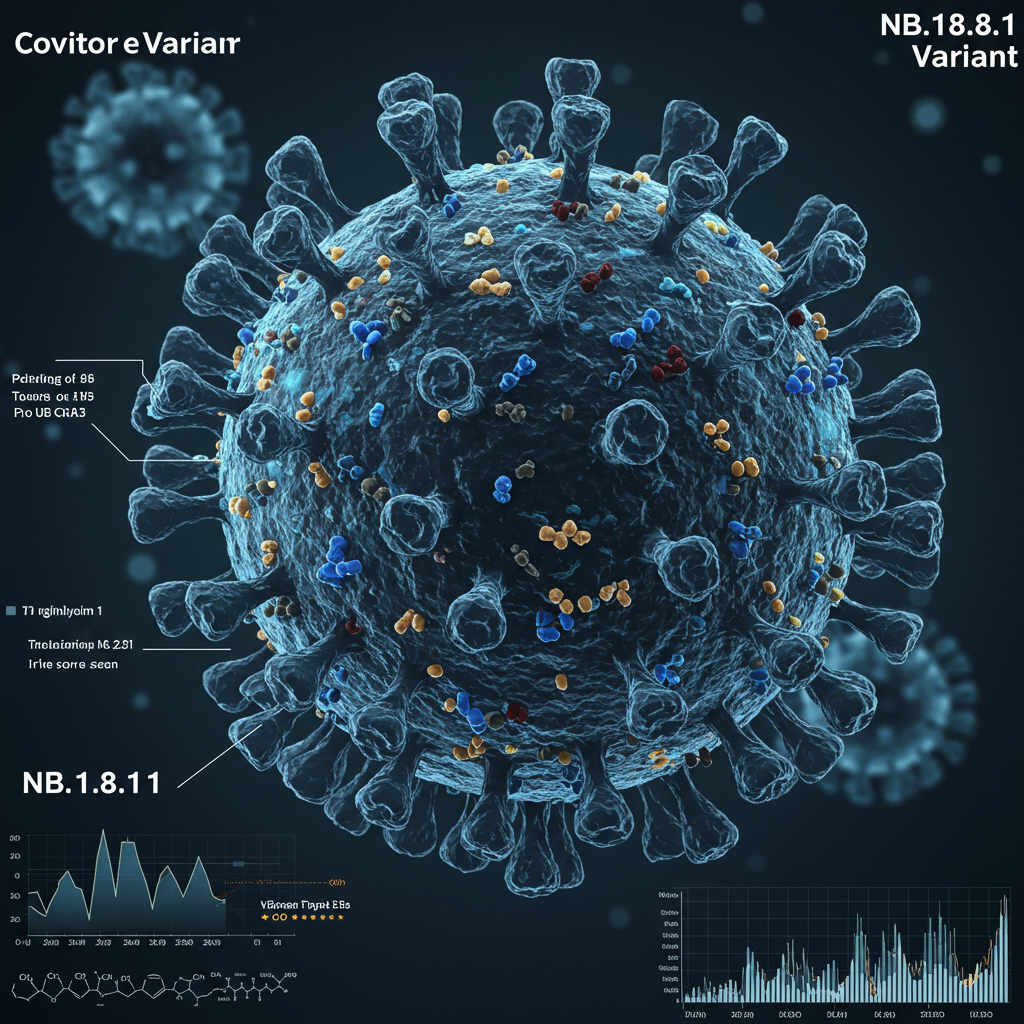Concerns often arise as new variants of SARS-CoV-2, the virus causing COVID-19, emerge and spread. One variant recently drawing attention is NB.1.8.1, sometimes informally referred to as “Nimbus.” Authorities and health experts are closely monitoring its rise globally and in the United States.
What is the NB.1.8.1 Variant?
NB.1.8.1 is an Omicron-descendant lineage, specifically derived from the recombinant variant XDV.1.5.1. It shares similarities with LP.8.1, which has been a dominant variant in recent months. First detected in Asia in January 2025, NB.1.8.1 was classified as a “variant under monitoring” (VUM) by the World Health Organization (WHO) on May 23, 2025, due to its rapid spread and specific mutations.
How is NB.1.8.1 Spreading?
The NB.1.8.1 variant is demonstrating rapid global spread. From late March through May 2025, it was detected through airport screening programs among international travelers arriving in the U.S., including at major hubs in California, Washington state, Virginia, and the New York City area.
Since then, its presence has grown. By early June 2025, NB.1.8.1 accounted for an estimated 37% of COVID-19 cases in the U.S. over a two-week period, making it the second-most common variant, nearly matching the dominant LP.8.1. While precision in these figures is currently limited due to decreased sequencing data, the variant has been confirmed in at least 14 states across the U.S. Globally, the WHO reported in mid-May that NB.1.8.1 had been found in at least 22 countries and represented over 10% of global cases. It has been linked to significant surges in places like China and Hong Kong.
Understanding Transmissibility and Immune Evasion
SARS-CoV-2 constantly evolves, and new variants often possess mutations that can influence how easily they spread or how well they evade existing immunity. NB.1.8.1 carries several mutations in its spike protein. Preliminary, non-peer-reviewed studies suggest these mutations may improve its ability to bind to human cells, potentially enhancing transmissibility and giving it a “potential for future dominance.” Experts generally agree it is likely highly contagious, similar to other Omicron strains, although direct comparison to currently circulating variants is challenging with available data.
Regarding immune evasion, preliminary data is mixed. Some research suggests NB.1.8.1 might offer marginal immune evasion compared to variants like LP.8.1, while other studies indicate it’s not significantly superior in this regard. However, its rapid spread globally is a key reason it’s under monitoring.
Symptoms and Severity: Is NB.1.8.1 More Dangerous?
Importantly, current data does not indicate that the NB.1.8.1 variant causes more severe illness than other circulating variants. The WHO assessed the public health risk posed by NB.1.8.1 as low as of May 23, 2025. Symptoms associated with NB.1.8.1 appear consistent with those of recent Omicron strains:
Sore throat
Cough
Runny nose or congestion
Fatigue
Fever or chills
Headache
Body aches
Shortness of breath
Diarrhea
Potential loss of smell or taste
While the variant itself isn’t linked to increased severity, localized surges like those seen in Hong Kong and Taiwan have coincided with an increase in emergency room visits, hospitalizations, and severe cases. This may be a consequence of a higher number of total infections rather than NB.1.8.1 causing a higher percentage of severe cases per infection compared to other variants.
Vulnerable populations, such as individuals over 65, those who are immunocompromised, or people with underlying medical conditions, still face a higher risk of severe outcomes from any COVID-19 infection. The risk of long COVID is also believed to increase with repeat infections.
Potential for a Summer Uptick in Cases
Experts anticipate an increase in COVID-19 cases in the U.S. during the summer months (June-August). While many respiratory viruses are seasonal in winter, COVID-19 has shown a tendency for summer surges, contributing to a “two-humped camel” pattern of peaks throughout the year. Factors contributing to potential summer spread include the virus’s ability to adapt to warmer, humid weather, waning population immunity from previous infections or vaccinations, increased summer travel, and social gatherings, often indoors in air-conditioned spaces.
It remains uncertain whether NB.1.8.1 will be the primary driver of a potential summer wave or simply contribute to it alongside other variants. However, due to high levels of population immunity (estimated over 90% in the U.S. from prior infection or vaccination), any potential surge is expected to be less severe than those experienced earlier in the pandemic.
Protection: Vaccination and Staying Safe
Vaccination remains a critical tool for protection against severe illness, hospitalization, and death from COVID-19. The 2024-2025 COVID-19 vaccines are still available and recommended for most adults aged 18 and older, as well as everyone aged six months and older according to earlier guidance. Health authorities and experts expect these current vaccines to remain effective in protecting against severe outcomes from NB.1.8.1 infection.
Looking ahead, updated 2025-2026 COVID-19 vaccines designed to target the LP.8.1 variant are anticipated in the fall. Studies suggest vaccines targeting LP.8.1 should also provide good cross-protection against other circulating variants like NB.1.8.1.
However, recent updates to vaccine guidelines may impact who is routinely recommended or able to easily access these updated shots. Routine vaccination is no longer recommended for healthy children and pregnant women by recent HHS statements, a change met with some disagreement from medical professionals. Furthermore, updated or annual vaccines for healthy individuals under 65 may require new clinical trials for approval, potentially affecting their broad availability and cost. Individuals over 65 or with underlying medical conditions are expected to be prioritized for the updated shots in the fall.
Beyond vaccination, continuing basic protective measures is advised, especially as cases potentially rise:
Testing if you develop symptoms or after exposure.
Isolating if you are sick.
Avoiding close contact with individuals who are unwell.
Considering wearing a well-fitting mask (like an N95) in crowded indoor settings.
- Practicing good hand hygiene and covering coughs/sneezes.
- www.today.com
- www.today.com
- www.nicd.ac.za
- www.cbsnews.com
- www.usatoday.com
While government-provided free at-home test kits are less common, low-cost or free testing options may still be available, including free testing for uninsured individuals through specific federal programs.
Continued Monitoring
Global and national health authorities, including the WHO and CDC, continue to monitor the evolution of SARS-CoV-2, including the spread and characteristics of the NB.1.8.1 variant. Surveillance efforts, though sometimes limited by decreased testing and sequencing compared to earlier in the pandemic, are key to understanding the virus’s trajectory and informing public health guidance. While the overall risk from NB.1.8.1 is currently assessed as low, its potential for increased transmissibility means ongoing attention is warranted.



